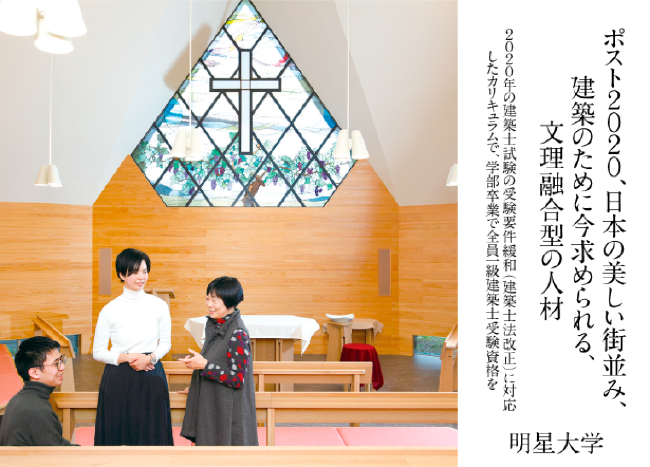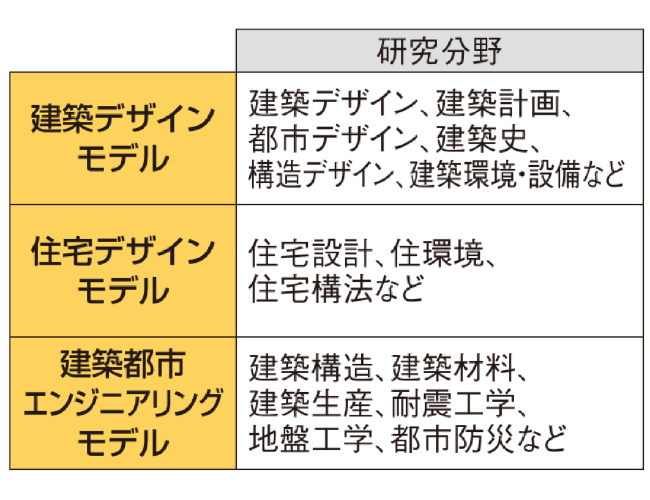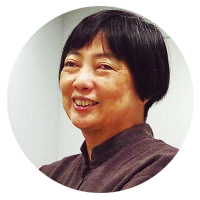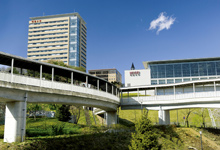With a curriculum that responds to the relaxation of the requirements for the architect examination in 2020 (revised the Architect Law), all graduates of the undergraduate school are qualified to take the first-class registered architect examination.

Why is the Japanese cityscape not beautiful?
The cause must be traced back to the Meiji era, when the wooden-centered circular buildings and cityscapes up to the Edo period were transformed into brick and stone Western architecture and Western cityscapes.
The word "architecture" was coined in the late Edo period, but the reason why it was generally recognized is that Chuta Ito * tried to spread the word "architecture" by changing the name of "architectural institute" to "architectural institute" at that time. increase. I thought that the word "building house" had no artistic meaning, so I changed the name to "architecture", which is different from functional structures.
"Architecture" is a term that expresses an abstract concept that includes science and art, paying attention to history, culture, and people's daily lives.His ideas had a great influence on the architectural world after that, and until the late Taisho era, many beautiful brick and stone buildings appeared in Japan, which had only wooden buildings until the late Taisho era.
However, after the Great Kanto Earthquake of 1923 (Taisho 12), safety and disaster prevention were the top priorities for Japanese buildings and cityscapes, and the way of thinking about architecture was changed to one that emphasized structural design, that is, engineering elements.This trend was spurred on by the reconstruction of the land after World War II and the subsequent high-growth period.With the top priority being to increase the number of houses due to the rapid population increase and the follow-up of legal development, I think that the buildings were uniform and lacking in individuality, and the cityscape had to be messy.This trend seemed to be held back by the bursting of the bubble economy, but the globalization that began immediately afterwards promoted a concentration in Tokyo, and the formation of a central city by skyscrapers was the formation of other major cities. Expectations for a beautiful city space have fallen sharply.At the same time, I don't think it is necessary to explain further that the local exhaustion has progressed.I would like to hear the opinions of young people as to whether such urban policies and urban development lead to the affluence and happiness of the lives of the residents.
Responding to future architectural issues by taking advantage of the advantages of an integrated university
However, in recent years, the situation surrounding super-aging, low growth, depopulation society, architecture, and cityscape has changed completely.Therefore, on the premise of the high growth so far, it may be necessary to reset the economy-priority architecture and urban development without ideas, and change the paradigm for the future.At the same time, there is an urgent need to develop architectural professionals and citizens with new values, and to reform architectural education at universities.
In Europe, where the architectural tradition is deeply rooted, building a house is more familiar than in Japan, and the residents' sense of ownership of buildings and cityscapes is much higher.I have been enthusiastic about architectural education since I was a child, and many of the architecture departments at the university are independent, and in addition to arts and aesthetics, there are also abundant subjects in humanities and social sciences such as economics and psychology. , Liberal arts education with a system centered on architecture.Moreover, in Italy, which has a tradition since Michelangelo, there are some with 5000 students.Of course, not all graduates become architects, but we have produced a large number of citizens and administrative staff who have a basic background in architecture and are highly conscious of urban development and the environment around them.
Applying this to the development of architectural human resources (architectural professionals) in Japan, I think that having the Faculty of Architecture in an integrated university is a great strength.This is because it is easier to focus on liberal arts education, literary and science-based education, and, in recent terms, STEAM education, compared to the architecture departments, architecture majors, and architect training programs located within engineering and science and engineering universities and faculties.
In recent years, the fusion of humanities and sciences is often talked to students and students in the humanities with a view to the evolution of AI and the transition to Society 5.0. It is important.It is indispensable for science human resources and engineers in the future to raise awareness of various issues in society, issues symbolized by the SDGs when looking at the world as a whole, and ethical standards that are responsible for the construction of social infrastructure. That's why.
For this reason, next spring, Meisei University will expand the scale of the conventional Faculty of Science and Engineering, Department of Comprehensive Science and Engineering, and establish a new Faculty of Architecture.The catchphrase is "Smile more in the world with the power of architecture", looking ahead to post 2020, pursuing the ideal form of architecture and architecture, and pursuing "architecture as an anthropology integrated with human science". ..

Learn with XNUMX models, and qualify for the first-class registered architect exam at the time of graduation
The major feature of the curriculum is that we have prepared three courses from the second year."Architectural design" to learn about architecture in general, "Housing design" for people who like their surroundings and housing, earthquake resistance engineering, structural design, geotechnical engineering, hydraulics, social infrastructure such as urban environment, or analysis, etc. It is "architectural city engineering" that you can learn.In each case, in the third year, there is a "design studio subject" where you can move your hands to make things based on what you have learned so far, and emphasize learning from experience.In addition, in Architectural City Engineering, we will continue to focus on regional and corporate collaboration with local business and industry associations since its establishment.
The number of full-time faculty members (laboratory) has increased from the current 10 to 18.We also have practitioner teachers, community design teachers who think about consensus building with citizens and housing planning in apartment buildings, and woodworking specialists who will be inevitable in the future.

At the same time, in order to respond to the relaxation of the requirements for the registered architect examination from 2020, by acquiring all the credits of the required subjects, we will be able to qualify for the first-class registered architect examination at the time of graduating from the undergraduate school. We will ask you to put more effort into the accumulation from the first year, and in the fourth year, we will set up an examination preparation course in parallel with the graduation research.
The faculty of architecture is conspicuous nationwide, but I welcome all the studies of architecture at domestic universities to become the faculty of architecture.However, in the Kanto region, our university was the first to open the way for humanities.
The interests of liberal arts people may overlap with the Faculty of Law, Public Policy, Economics and Management, but the curriculum of all new faculties is such that they can qualify for the first-class registered architect exam at the time of graduation. Varies.I've seen discussions at various levels about architecture and urban development, but when it comes to it, the trust that people who can and cannot make things on their own is completely different.Please look forward to the new faculty, which will deepen your insight into your area of interest and aim to become a first-class registered architect.
I also look forward to the humanities
One of the major features of the new faculty is that the entrance examination has opened the way for people in the humanities.I am interested in human beings and want to clean the world and Japan.Anyone who has a simple question about Japanese architecture or town planning, or who has a strong interest in architecture or town planning, is welcome even if you are a liberal arts person.Originally, I think that there are many people in the humanities who want to face social issues.I would like you to boldly challenge the social issues of Post 2020, the conventional industry practices, and the common sense of architectural design and town planning, and aim to be an architect who can be said to be "funny" if it seems strange.
Of course, it is not called number III, and it is not necessary for you to learn up to number IIB, but you can take the exam even if you do not.Unless you proceed to materials research, you should acquire the basic mathematics, analysis and geometry, and mechanics of physics necessary for structural calculation even after entering university if you have a strong desire to study architecture. I can.On the contrary, I would like all science students not to throw away their national language and history because they are not necessary for the examination.For architecture, it's just as important as mathematics in learning the principles for rationally constructing things.
Short essays and presentation entrance exams are back again.
The architecture of Meisei University began in 2005 (Department of Architecture, Faculty of Science and Technology).I had a unique presentation entrance exam, but it disappeared in 2010 when the Faculty of Science and Engineering was reorganized (to the Department of Architecture, Department of Comprehensive Science and Engineering).With this undergraduate program, the entrance exams that high school students with a humanities and arts mindset can take on are revived at AO. (Implemented in the XNUMXst and XNUMXnd)

Expected Dean of the Faculty of Architecture
Professor Akiko Murakami
Graduated from the Department of Architecture, Faculty of Fine Arts, Tokyo University of the Arts in 1984. Completed the Department of Architectural Design, Graduate School of Fine Arts, Tokyo University of the Arts in 1986. Joined Sakakura Associates in 1986. 2001 Established Akiko Murakami Atelier First Class Architect Office. 2005-Professor, Department of Architecture, Faculty of Science and Technology, Meisei University (currently Department of Comprehensive Science and Engineering). 2008-2013 Kyushu University Visiting Professor, Ph.D. (Engineering) Kyushu University.Registered architect of Japan Institute of Architects.First-class architect and welfare living environment coordinator.Born in Kanagawa Prefectural Shonan High School.

